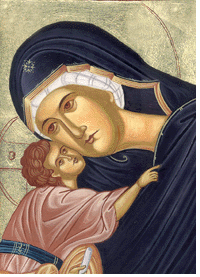...Best of Sicily presents... Best of Sicily Magazine. ... Dedicated to Sicilian art, culture, history, people, places and all things Sicilian. |
by Antonella Gallo | ||
Magazine Index Best of Sicily Arts & Culture Fashion Food & Wine History & Society About Us Travel Faqs Contact Map of Sicily |
The traditional creation of an icon is a painstaking and time-consuming process using natural materials. Canvas is stretched over a hardwood (bass, oak, poplar) panel and given several coats of gesso, a substance similar to plaster, made from chalk or marble dust mixed with rabbit skin glue. Then red "clay" (or "earth" pigment) is applied to the areas where gold leaf will cover the surface, and also to edges and other areas which will not be covered by colour. The basic lines of the images are traced onto the white sections of the surface and painted in opaque tones in egg tempera. The artist works from medium and darker tones toward lighter ones, in a process symbolizing the voyage from darkness to light. People who view actual original icons are often struck by their simple pictorial composition and the peaceful impression they evoke. Iconography, in fact, is the form of art on which subsequent European painting (even oil painting) was based. To believers, the painting of an icon is almost a spiritual experience and the icon, once blessed by a priest, becomes a religious symbol. In English, it is often said in the Orthodox Church that the iconographer does not "paint" an icon. Rather, he or she "writes" it. This is based on a mistranslation of the Slavonic words for "painting" and "writing," but it is a reminder that painting an icon is unlike painting any other work of art. Iconography is Christianity's oldest artform. The figures in an icon are represented as they are believed to exist in Heaven. Mosaic icons are an important part of Sicily's multicultural artistic heritage, and can be seen in Taormina, and especially around Palermo (Monreale Abbey, Cefalù Cathedral, the Palatine Chapel and the Martorana Church). The art and technique of icon painting, however, almost disappeared during eight centuries of "Latin" influence which fostered the Gothic, Renaissance and Baroque movements in Sicilian art and architecture. Iconographic art has been maintained, in a small way, by artists in Sicily's Greek and Albanian communities. Sicily, the place where East and West meet, has never forgotten her Byzantine history. There was a time, as the Western Roman Empire crumbled in the face of corruption, invasions and a "new" religion, that the only public art was "Christian" art. Religious icons, while resembling stylized portraits, actually "represent" their subjects rather than "depict" them literally. This is intentional. Physical proportions are "distorted," while perspective is treated in a surreal manner even as details such as clothing and landscapes are often strikingly natural. In viewing an icon, one almost imagines that the Renaissance, with its scientific and humanistic influences, never took place. Icon painting is one of the few visual arts that has not changed since the fifth century. Beauty, not science, is its focus. The woman behind these timeless images is Veronica Hadarag. Veronica, whose style of painting gives her work a medieval aura, resides in Palermo. She learned her art in the Moldova region of Romania. About the Author: Antonella Gallo, who teaches art in Rome, has written numerous articles on arts and artists for Best of Sicily. | |
Top of Page |
 Icons are part of
Eastern tradition. The art of iconography, or hagiography, has ancient origins,
but the traditional technique most widely used today dates from the earliest
years of the Middle Ages, when Sicily's religion and rulers were Byzantine
(and Orthodox). Icons aren't unique to Sicily or eastern Europe. Until the
Schism divided the early Church in the eleventh century, these images were
popular in churches and homes across Europe. While icons represent Christianity's
holy images, you don't have to be a Christian to appreciate their timeless
Byzantine beauty. That's the greatest thing about icons. Some
people collect icons, just as others collect Impressionist paintings or
Renaissance drawings. It's important, however, to distinguish between "assembly
line" icons and the kind of works created by Veronica Hadarag. Theotokos, shown here, is a traditional Madonna.
Icons are part of
Eastern tradition. The art of iconography, or hagiography, has ancient origins,
but the traditional technique most widely used today dates from the earliest
years of the Middle Ages, when Sicily's religion and rulers were Byzantine
(and Orthodox). Icons aren't unique to Sicily or eastern Europe. Until the
Schism divided the early Church in the eleventh century, these images were
popular in churches and homes across Europe. While icons represent Christianity's
holy images, you don't have to be a Christian to appreciate their timeless
Byzantine beauty. That's the greatest thing about icons. Some
people collect icons, just as others collect Impressionist paintings or
Renaissance drawings. It's important, however, to distinguish between "assembly
line" icons and the kind of works created by Veronica Hadarag. Theotokos, shown here, is a traditional Madonna.